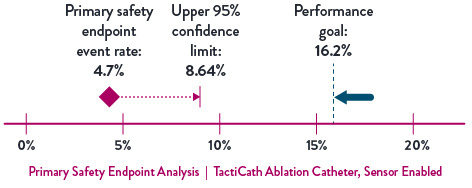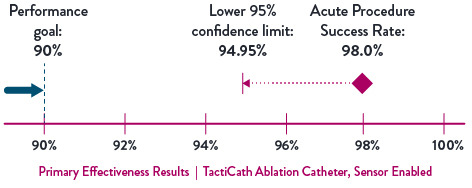Clinical Evidence
TactiSense IDE: TactiCath Catheter, Sensor Enabled Safety and Effectiveness
Study Conclusion: The TactiSense IDE results through 30 days demonstrate that the TactiCath™ Contact Force Ablation Catheter, Sensor Enabled™ is safe and effective for the treatment of paroxysmal atrial fibrillation.
(TactiSense IDE study. TactiCath SE IFU #ARTEN600049107 A, 2018-09.)
TactiSense IDE study – included in TactiCath SE catheter IFU
- Prospective, multi‐center, single‐arm clinical trial to demonstrate acute safety and effectiveness of TCSE for treatment of PAF
- Study met primary endpoints
- Safety: Rate of device or procedure-related primary SAEs within 7 days
- Effectiveness: Acute procedural success, defined as confirmation of entrance block in all pulmonary veins
Endpoints
- There are two primary endpoints and ten descriptive endpoints. Results of the primary endpoints and first three descriptive endpoints were analyzed for this primary analysis. The remaining endpoints will be reported after 1-year follow up results are available.
- Primary Safety: The rate of primary device or procedure-related serious adverse events (SAEs) occurring within 7 days of the index procedure. Atrial-esophageal fistula, cardiac perforation/tamponade, and pulmonary vein stenosis that occur >7 days post procedure through 30 days also contributed to the primary endpoint. Primary event criteria were prespecified.
- Primary Effectiveness: Acute procedural success, defined as confirmation of entrance block in all pulmonary veins.
- Descriptive endpoints:
- Ablation data collected during the procedure, including: Power, Temperature, Irrigation flow rate, Contact Force, Procedure time, Total ablation time, Total fluoroscopy time, Total RF application time, Use of AutoMark
- Proportion of index cases achieving ≥90% lesions with ≥10 g contact force
- SAEs and adverse events related to the procedure and/or ablation catheter through 30 days
TactiSense met primary safety endpoint
The observed rate of primary safety endpoint events was 4.7% (one-sided 95% upper confidence limit: 8.64%) and was statistically significantly lower than the predetermined performance goal of 16.2% (p<0.0001) for the TactiCath Contact Force Ablation Catheter, Sensor Enabled.

| Primary Safety Endpoint (SAF population) | Tacticath SE (N=149) | Upper One-sided 95% CL | Performace Goal1 | P-value2 |
|---|---|---|---|---|
| Subject experienced primary safety endpoint event (Device or procedure-related primary SAE) | 7 (4.7%) | (8.64%) | 16.2% | <0.0001 |
1 One-sided upper 95% confidence limit by Clopper Pearson Method.
2 One-sided p-value by using Binomial Exact Test against the performance goal of 16.2%, to be compared with one-sided significance level of 0.05.
TactiSense primary safety endpoint events
| TactiSense IDE Primary Safety Endpoint Events (SAF population) | N (%) Subjects, N=149 |
|---|---|
| Atrial-esophageal fistula | 1 (0.7%) |
| AV block | 0 (0.0%) |
| Cardiac perforation/tamponade | 3 (2.0%) |
| Death | 0 (0.0%) |
| Diaphragmatic paralysis | 0 (0.0%) |
| Gastroparesis | 0 (0.0%) |
| Hospitalization | 0 (0.0%) |
| Myocardial Infarction | 0 (0.0%) |
| Pericarditis | 1 (0.7%) |
| Pneumothorax | 0 (0.0%) |
| Pulmonary edema | 0 (0.0%) |
| Pulmonary vein stenosis | 0 (0.0%) |
| Stroke | 0 (0.0%) |
| Thromboembolism | 1 (0.7%) |
| Transient ischemic attack | 0 (0.0%) |
| Vascular Access Complication | 2 (1.3%) |
| Total Device or Procedure-related Primary SAEs | 0 (0.0%) |
TactiSense met primary effectiveness endpoint
Acute procedural success was achieved in 98.0% (148/151) subjects who had the TactiCath Contact Force Ablation Catheter, Sensor Enabled inserted into the vasculature. The lower bound of the one-sided 95% confidence interval was 94.95%, which is greater than the performance goal of 90%. Therefore, the null hypothesis was rejected and the primary effectiveness endpoint passed.

| Primary Effectiveness Endpoint (EFF population) | Tacticath SE (N=151) | Lower One-sided 95% CL1 | Performace Goal | P-value2 |
|---|---|---|---|---|
| Acute Procedure Success* | 98.0 (148/151) | 94.95% | 90% | 0.0001 |
1One-sided lower 95% confidence limit by Clopper Pearson Method.
2One-sided p-value by using Binomial Exact Test against the performance goal of 90%, to be compared with one-sided significance level of 0.05.
*The primary effectiveness endpoint was acute procedure success, defined as confirmation of entrance block at least 30 minutes after the last ablation in each pulmonary vein.
TactiSense IDE: Key procedural results
| TactiSense IDE Descriptive Endpoints Procedural Characteristics | (EFF Population) Total N=150 |
|---|---|
| Was the recommended power of 10-30W used? (% Yes) | 58.7% (88/150) |
| Average RF power (W) | Median (Q1, Q3): 29.0 (26.0, 32.0) (n=149) |
| Average contact force (g) per subject | Mean ± SD: 12.1 ± 4.7 Median (Q1, Q3): 11.2 (8.5, 14.3) Range (min, max): (5.0, 32.0) (n = 149) |
| % of patients achieving ≥ 90% lesions with ≥10 g contact force | 3.4% (5/149) |
| Total procedure time (min) | Median (Q1, Q3): 159.5 (123.0, 206.0) (n=150) |
| Total RF time (entire case in min) | Median (Q1, Q3): 35.7 (28.9, 51.9) (n=149) |
| Fluoroscopy time (min) | Median (Q1, Q3): 9.0 (5.0, 16.0) (n=150) |
| AutoMark turned on for procedure? (Yes) | 99.3% (149/150) |
| Was AutoMark used to guide therapy? (Yes) | 92.6% (125/135) |
1 TactiSense IDE study. TactiCath SE IFU #ARTEN600049107 A, 2018-09.
*Effortless handling is based on how physicians scored catheter handling characteristics during an initial market release.
MAT-2103109 v1.0
